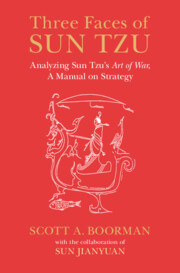Contents
E.Strategist Should Make a Situation’s Natural Dynamics Work for Her
F.Strategist Should Have an Accurate Grasp of the Significant Information
- Indices
- Online Annex
- Contents of Online Annex A-1
- Lists Supplying Chinese Characters A-3
- Scholarly Controls A-24
- Use of Griffith Translation and Related Notational Conventions A-24
- Passage Identification Criteria A-25
- Multiple Thematic Assignments of Verses and Passages A-28
- Coverage of Appendices 1–14 A-29
- Census of Sun Tzu Passages A-33
- Brooks’s Proposed Accretion Sequence of Sun Tzu Chapters A-33
- Overview of Problematic Parts of the Sun Tzu Text A-36
- Roadmap of Supplementary Passages in Appendices 1–14 A-38
- Appendix 1.Sun Tzu Theme #1 Passages (Calculation) A-39
- Appendix 2.Sun Tzu Theme #2 Passages (Terrain Classification and Rules) A-64
- Appendix 3.Sun Tzu Theme #3 Passages (Cheap Approaches) A-86
- Appendix 4.Sun Tzu Theme #4 Passages (Winning by Non-military Ways and Means) A-102
- Appendix 5.Sun Tzu Theme #5 Passages (Concept of Shi, “Strategic Advantage,” and Four Paths to Shi) A-118
- Appendix 6.Sun Tzu Theme #6 Passages (Attacking the Adversary’s Strategy) A-131
- Appendix 7.Sun Tzu Theme #7 Passages (Deception) A-144
- Appendix 8.Sun Tzu Theme #8 Passages (Formlessness and Opacity) A-156
- Appendix 9.Sun Tzu Theme #9 Passages (Building on Natural Forces and Momentum) A-168
- Appendix 10.Sun Tzu Theme #10 Passages (No Scruples and Controlled Viciousness) A-184
- Appendix 11.Sun Tzu Theme #11 Passages (Know the Enemy) A-194
- Appendix 12.Sun Tzu Theme #12 Passages (Know Yourself and Other Non-hostile Actors and Audiences) A-210
- Appendix 13.Sun Tzu Theme #13 Passages (Leadership and Harmony in the Chain of Command) A-222
- Appendix 14.Sun Tzu Theme #14 Passages (Integration of Qi and Zheng Approaches) A-235
- Appendix 15.Two Additional Sun Tzu Military-Technical Topics A-257
- Appendix 16.Concordance of Sun Tzu Verses and Passages Used in the Present Study A-280
- Appendix 17.Griffith Translation of Sun Tzu, Showing Griffith Versification A-281
- Index A(supplementary): Chinese Texts A-317
- Index B(supplementary): People, Organizations, Places, Events, and Pre-modern Periods of Chinese History A-318
- Index CAnalytical Index of Substantive Topics (Separate Document in Online Annex)



